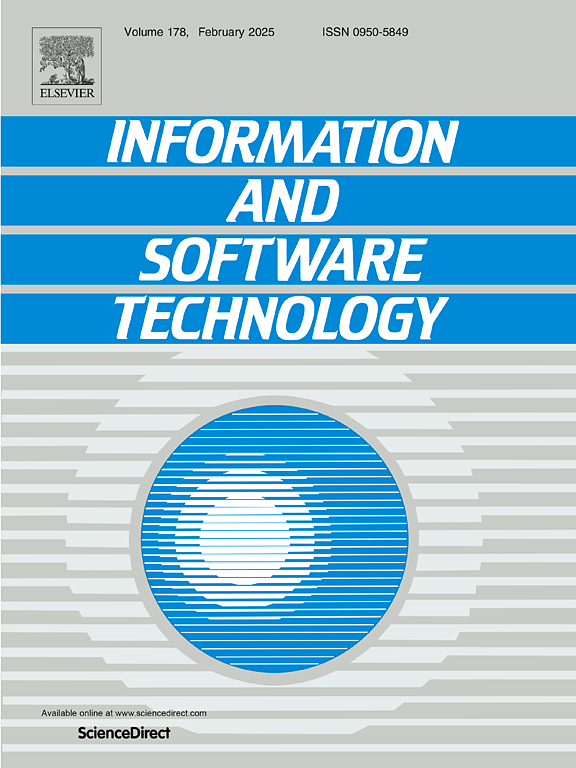BTAL: An imbalance software bug report triage approach based on BERT-TextCNN
IF 4.3
2区 计算机科学
Q2 COMPUTER SCIENCE, INFORMATION SYSTEMS
引用次数: 0
Abstract
With the expansion of software project scale, a large number of software bug reports have been generated. Bug triage is an indispensable task in software development and maintenance, which directly affects the efficiency of software bug fixing and maintenance cost. Existing bug triage methods often fail to make full use of the useful information in defect reports, resulting in the neglect of some auxiliary information that is critical to the defect triage task. Meanwhile, they also fail to take into account the uncertainty of developers’ work and the gap in their activity, thus leading to the imbalance in software defect report datasets. To address this issue, we propose an imbalance software bug report triage method, BTAL, based on BERT-TextCNN. Firstly, the method utilizes multiple information from software bug reports and employs BERT and TextCNN models for vector representation and feature extraction. Then, the output feature vectors are input into the softmax function to obtain the probabilities of bug reports being triaged to developers. To solve the problem of imbalanced datasets, we propose an adaptive loss function that can adaptively adjust the loss weights based on different categories of samples. This helps the network reduce its focus on majority classes and increase its focus on minority classes, thereby improving triage accuracy. Experimental results on five large-scale open-source software projects, namely GCC, NetBeans, Eclipse, Mozilla, and OpenOffice, demonstrated the effectiveness of the BTAL method in solving software bug triage problems, outperforming current state-of-the-art models.
BTAL:一种基于BERT-TextCNN的失衡软件bug报告分类方法
随着软件项目规模的扩大,产生了大量的软件bug报告。Bug分类是软件开发和维护中不可缺少的一项工作,它直接影响到软件Bug修复的效率和维护成本。现有的缺陷分类方法往往不能充分利用缺陷报告中的有用信息,导致忽略了一些对缺陷分类任务至关重要的辅助信息。同时,他们也没有考虑到开发人员工作的不确定性和他们活动的差距,从而导致软件缺陷报告数据集的不平衡。为了解决这个问题,我们提出了一种基于BERT-TextCNN的失衡软件bug报告分类方法BTAL。首先,该方法利用软件bug报告中的多种信息,采用BERT和TextCNN模型进行向量表示和特征提取;然后,将输出的特征向量输入到softmax函数中,以获得bug报告被分类到开发人员的概率。为了解决数据集不平衡的问题,我们提出了一种自适应损失函数,可以根据不同类别的样本自适应调整损失权值。这有助于网络减少对多数类别的关注,增加对少数类别的关注,从而提高分类准确性。在五个大型开源软件项目(GCC、NetBeans、Eclipse、Mozilla和OpenOffice)上的实验结果表明,BTAL方法在解决软件bug分类问题方面的有效性优于当前最先进的模型。
本文章由计算机程序翻译,如有差异,请以英文原文为准。
求助全文
约1分钟内获得全文
求助全文
来源期刊

Information and Software Technology
工程技术-计算机:软件工程
CiteScore
9.10
自引率
7.70%
发文量
164
审稿时长
9.6 weeks
期刊介绍:
Information and Software Technology is the international archival journal focusing on research and experience that contributes to the improvement of software development practices. The journal''s scope includes methods and techniques to better engineer software and manage its development. Articles submitted for review should have a clear component of software engineering or address ways to improve the engineering and management of software development. Areas covered by the journal include:
• Software management, quality and metrics,
• Software processes,
• Software architecture, modelling, specification, design and programming
• Functional and non-functional software requirements
• Software testing and verification & validation
• Empirical studies of all aspects of engineering and managing software development
Short Communications is a new section dedicated to short papers addressing new ideas, controversial opinions, "Negative" results and much more. Read the Guide for authors for more information.
The journal encourages and welcomes submissions of systematic literature studies (reviews and maps) within the scope of the journal. Information and Software Technology is the premiere outlet for systematic literature studies in software engineering.
 求助内容:
求助内容: 应助结果提醒方式:
应助结果提醒方式:


